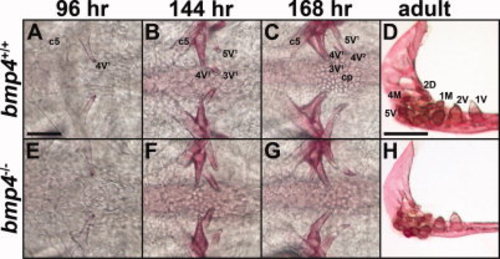- Title
-
bmp2b and bmp4 are dispensable for zebrafish tooth development
- Authors
- Wise, S.B., and Stock, D.W.
- Source
- Full text @ Dev. Dyn.
|
Dentition in bmp4st72 homozygotes. A-C, E-G: Alizarin-stained larvae (ventral views of fifth ceratobranchials and associated teeth, anterior to the left) at 96, 144, and 168 hpf showing one, three, and four teeth per side, respectively, in wild type and bmp4st72 homozygotes. 4V1, 3V1, 5V1, and 4V2 designate individual teeth according to the terminology of Laurenti et al. (2004). D, H: Left fifth ceratobranchials (anterior to the right, dorsal up) of 8-month-old fish show five ventral row (V), four mediodorsal row (M), and two dorsal row (D) teeth in wild type and bmp4st72 homozygotes. Numbers in D indicate individual teeth within rows. Scale bar in A = 50 μm for A?C, E?G; in D = 500 μm for D, H. c5, fifth ceratobranchial; cp, keratinized chewing pad. |
|
Effects of a bmp2b MO on tooth development. A-C: 108-hpf alizarin-stained larvae (orientation as in Fig. 1) injected with standard control or bmp2b MO and classified into phenotypic severity classes C2 or C3. Left side teeth are designated as in Figure 1. D-L: Expression of markers of tooth germs (pitx2, 48 hpf; dlx2b, 60 hpf) or neural crest cells (dlx2a, 48 hpf) in control MO-injected (D, G, J) and bmp2b-MO injected embryos of phenotypic class C3 (E, H, K) and C4 (F, I, L). Lateral views with anterior to the left. Arrowheads indicate tooth germs (D, E, G, H, J, K) or the location of posterior arch neural crest cells (F, I, L). M:dlx2b expression in tooth germs (arrowhead) of wild type 56-hpf larva (dorsal view, anterior to left). N:dlx2b expression (arrowhead) in transplanted cells (stained brown) targeted to the endoderm and containing a bmp2b MO. O: Transverse section showing transplanted bmp2b MO-containing endodermal cell contribution (stained brown) to the endoderm of a pharyngeal tooth (left arrowhead) in an 84-hpf embryo. Right arrowhead indicates mineralized tooth developed from host cells. Scale bar in A = 50 μm for A?C, in D = 100 μm for D-L; in M = 100 μm for M,N; in O = 50 μm. c5, fifth ceratobranchial; fb, forebrain; hg, hatching gland; n, notochord; pf, pectoral fin; s, stomodeum. |
|
Dentition in bmp2b;bmp4 compound mutants. A-I: Ventral views (anterior to the left) of fifth ceratobranchials and teeth in alizarin-stained 124-hpf larvae. Numbers in lower right of each panel indicate number of left and right side teeth, respectively. Early development of bmp2btc300a/tc300a larvae (G-I) was rescued by injection of bmp2b mRNA, while larvae of additional genotypes (A-F) were not injected. J, K: Left fifth ceratobranchials (anterior to the right, dorsal up) of 3-month-old bmp2btc300a/tc300a fish of indicated bmp4 genotype (rescued as above). V, M, and D indicate tooth counts for each row. L: Ventral view of teeth and fifth ceratobranchials of 15-dpf bmp2btc300a/tc300a;bmp4st72/st72 larva rescued by bmp2b mRNA injection. Left and right tooth numbers listed in lower right. Scale bar in A = 50 μm for A-I, in J = 500 μm for J,K; in L = 50 μm. |



